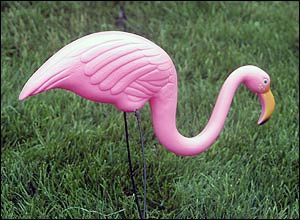Happy Pink Flamingo Day
What are pink, plastic, and iconic pieces of lawn art?
PINK FLAMINGOS! And, today is the day we honor and celebrate them.

No one is more excited than Myrtle. She is all a flutter. For those of you who don’t know, Myrtle is my traveling companion. I adopted her on the PBS Cruise and now she travels with me where ever I go. Myrtle has loads of cousins all over the country…there’s Mabel and Maribelle and Mildred and Matilda and lots of other M names…oh, and the latest is Mopsy who I rescued from a family of rabbits (Flopsy and Cottontail were so mean to her) and now lives in Oregon. Oh, did I happen to mention the Myrtle along with her cousins are inflatable pink flamingos? Oh, sorry….should have done that straight away. No wonder you all are so confused about why I’m going on and on about Myrtle when today is Pink Flamingo Day.
Did you ever wonder how those pink flamingos came about? Wonder no more… 
We owe it all to Don Featherstone, who was hired by Union Products of Leominster, MA, to produce a better piece of lawn art. Lawn art was the rage in the 1950. It was the one thing that could help personalize all those cookie-cutter houses built to contain the Baby Boomer generation without breaking the bank. Unfortunately, most lawn art was flat, two-dimensional, and without much character. Featherstone, a graduate from the Worcester Art Museum’s art school, crafted 3-dimensional pieces…a girl with a watering can…a boy with a dog…a duck…and, finally, in 1957, the flamingo.
“Big deal” you may say. But, what would you say if you learned he won a Nobel Prize for it?
Changed your tune did you or did you say “Really”? It’s true. He won a Nobel Prize…well, not THE Nobel Prize…it was the IG Nobel Prize for Art…but, still, it WAS a Nobel Prize.
On November 1, 2006, Union Products stopped producing the iconic pink flamingos. Luckily, HMC International LLC purchased the copyright and molds for the flamingos in 2007. Also in that year, Dean Mazzaralla, the mayor of Leominster, MA, declared June 23rd Pink Flamingo Day in honor of Mr. Featherstone and his pink creation.
Featherstone’s creation eventually spawned a new industry. Much of this industry – the lawn greeting industry – is based on installing flocks of pink flamingos on the lawns of poor unsuspecting people in the middle of the night. The act is known as “flocking”. I had to scratch my head and say “why?” Well, they get paid to do it, go figure.
There have been several famous “flockings”. Probably the most famous – or infamous – occurred over series of weeks in Celebration, Florida and had nothing to do with the lawn greeting industry. For those who don’t know, Celebration is a planned community…a Disney planned community. It has strict rules about what color you can paint your house, what color drapes you can have in your front windows, and…you guessed it…what kind of decorations you can place in your front yard. I am sure it will come as no surprise that plastic pink flamingos are NOT on the approved list. Be that as it may, a flock of flamingos would appear on a yard overnight… only to reappear the next night on another lawn…and, yet, another lawn the next night. This went on and on and on. Legend has it, the perpetrators were never actually caught, but everyone “knew” who the ring leader was. And, I’ve actually met the man. He’s currently the pastor of my daughter’s church in University Place, WA.
True! A couple of days ago, my DD mentioned that her pastor was going to go back to Florida. Back to Florida? That’s when it hit me that he had once been the pastor of the church in Celebration. Given that he is the Harley-riding kind of pastor, I thought, his personality would definitely fit the profile of the flamingo planting Celebration pastor. So, I did some googling and found confirmation in the way of an excerpt for Bill Geist’s book – Way Off the Road –
“Is there a flamingo underground? ‘I can’t talk about that,’ Reverend Wrisley replied. We’ll see about that. Might change his mind when we get him down to Disney headquarters?
The birds seem to migrate from yard to yard, staying one step ahead of the law. Can plastic flamingos fly? I asked.
‘If I told you, I’d have to kill you,’ he replies. ‘I…I just…I can’t tell you.’
Tough talk from this man of the cloth who does bear an uncanny resemblance to the perpetrator, caught on camera by our tireless night surveillance news team. Whoever’s responsible, it only goes to show that the best laid planned communities of mouse and men often go awry.
Reverend Wrisley predicts the flamingos will go forth and multiply ‘It’s ironic I think,’ he concludes, ‘that a plastic, gaudy pink flamingo in the land of the mouse represents reality.’”
And, with that, I conclude the PBS Blog celebrating Pink Flamingo Day!


Way off the Road by Bill Geist

Flight Maps: Adventures with Nature in Modern America by Jennifer Price

Flamingo Diner by Sherryl Woods

Cat in a Flamingo Fedora by Carole Nelson Douglas

Ink Flamingos by Karen E. Olson
(Which was reviewed here on the PBS by reacherfan1909 in June 2011. To read the review, click this LINK)



































